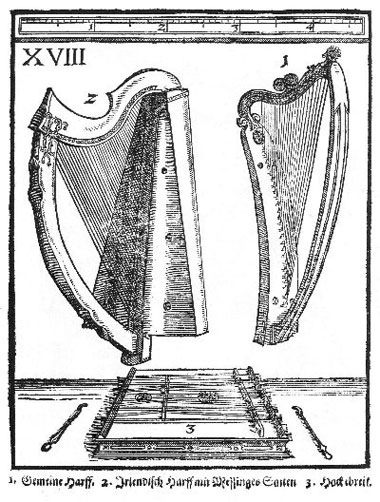
Plate 18. The Irlandische Harp
* N.B. The scale on the drawing is in Brunswick feet, which are slightly shorter than modern feet.
| Feature | Detail |
|---|---|
| Date | Pre – 1619 |
| String Count | 43 |
| Height | The scale on the illustration* would indicate 115 cm. (45 inches) |
| Soundbox | Unknown but likely to have been hollowed out from a single block. The width scales at about 45 cm. (18 inches) |
| Current Location | This example is a drawing; the harp itself is not known to exist |
The woodcut shown on the left (XVIII) is taken from Michael Praetorius’ 1619 publication Syntagma Musicum II, De Organographia, a volume that provides an invaluable insight into musical instruments known in early 17th–century Germany. With respect to the Irish harp, Praetorius not only reproduces this detailed illustration but also briefly relates the instrument’s beautiful sound and gives a gamut for the 43 brass strings. However, the apparent erratic sequence to the layout of the musical notes as printed in this work confused and baffled musicologists for many years, even leading to one dismissing this as “technically and practically absurd”. A solution to this conundrum was exhibited at the 1981 ‘Bun–Fleadh’, demonstrating how Praetorius' tuning could make sense and be understood if the strings were splayed into two rows and then tuned chromatically. This explanation was later published in an article in the journal Early Music which systematically presented the case for the existence of chromatic Irish harps in the 16th and 17th century. (see Michael Billinge and Bonnie Shaljean, ‘The Dalway or Fitzgerald harp’ Early Music, vol. XV, no. 2, May 1987, pp. 175–187.)
By including the ‘Irlandische Harff’ in his volume on musical instruments, Praetorius provides one of the most important pieces of evidence for the existence of chromatic Irish harps, a form of the instrument that until recently went largely unrecognised.